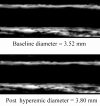Arterial stiffness or endothelial dysfunction as a surrogate marker of vascular risk
- PMID: 16498516
- PMCID: PMC2780833
- DOI: 10.1016/s0828-282x(06)70990-4
Arterial stiffness or endothelial dysfunction as a surrogate marker of vascular risk
Abstract
The understanding of the pathophysiology of atherosclerosis has advanced greatly in the past decade. Cardiovascular risk factors increase the likelihood of an adverse event by having a detrimental effect on the blood vessel wall. Abnormal interactions among cholesterol, inflammatory mediators, platelets and the vascular wall lead to atherogenesis and cardiac events. In an effort to better understand this process, develop surrogate end points for clinical trials and, ultimately, better risk stratify individuals, a variety of measures of arterial function have been studied. These include measures of endothelial health and arterial compliance. The current paper reviews the various techniques available for the study of vascular health. While not yet routinely used for clinical care, these measurements provide important insights into the pathophysiology and treatment of atherosclerosis.
La compréhension de la physiopathologie de l’athérosclérose a beaucoup progressé depuis dix ans. Les facteurs de risque cardiovasculaire augmentent la possibilité d’événement indésirable en raison de leur effet néfaste sur la paroi des vaisseaux sanguins. Des interactions anormales entre le cholestérol, les médiateurs inflammatoires, les plaquettes et la paroi vasculaire provoquent une athérogénèse et des troubles cardiaques. Afin de mieux comprendre ce processus, d’élaborer des paramètres ultimes de substitution en vue d’essais cliniques et, en bout de ligne, de mieux stratifier les individus selon leur risque, diverses mesures de la fonction artérielle ont été étudiées. Ces mesures incluent celles de la santé endothéliale et de la compliance artérielle. Le présent article permet d’analyser les diverses techniques disponibles pour étudier la santé vasculaire. Bien qu’elles ne soient pas encore utilisées systématiquement en soins cliniques, ces mesures donnent d’importants aperçus de la physiopathologie et du traitement de l’athérosclérose.
Figures




References
-
- Grundy SM, Pasternak R, Greenland P, Smith S, Jr, Fuster V. Assessment of cardiovascular risk by use of multiple-risk-factor assessment equations: A statement for healthcare professionals from the American Heart Association and the American College of Cardiology. Circulation. 1999;100:1481–92. - PubMed
-
- Wilson PW, D’Agostino RB, Levy D, Belanger AM, Silbershatz H, Kannel WB. Prediction of coronary heart disease using risk factor categories. Circulation. 1998;97:1837–47. - PubMed
-
- Ridker PM. Evaluating novel cardiovascular risk factors: Can we better predict heart attacks. Ann Intern Med. 1999;130:933–7. - PubMed
-
- Ridker PM, Brown NJ, Vaughan DE, Harrison DG, Mehta JL. Established and emerging plasma biomarkers in the prediction of first atherothrombotic events. Circulation. 2004;109:IV6–19. - PubMed
-
- Stampfer MJ, Ridker PM, Dzau VJ. Risk factor criteria. Circulation. 2004;109:IV3–5. - PubMed
Publication types
MeSH terms
Substances
LinkOut - more resources
Full Text Sources
Medical
Miscellaneous

